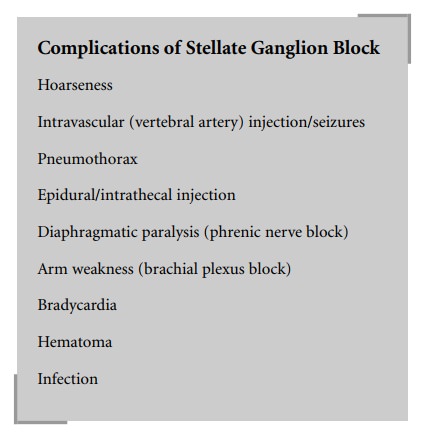Chapter: Clinical Cases in Anesthesia : Complex Regional Pain Syndrome
What different nerve blocks can be used for diagnosis and treatment of CRPS?
What
different nerve blocks can be used for diagnosis and treatment of CRPS?
The two most common sympathetic nerve blocks
utilized for both diagnosis and treatment of CRPS are stellate ganglion and
lumbar sympathetic blocks. The stellate gan-glion is a sympathetic ganglion made
up of the fusion of the inferior cervical and first thoracic sympathetic
ganglia. Anatomically, it is located near the transverse processes of C7
or T1 and has axons that arise from sympathetic cell bodies from the
T1–T5 spinal cord levels. Axons that pass through the
stellate ganglion supply sympathetic innerva-tion to the head, neck, and upper
extremities. Stellate ganglion blocks can also be used to treat upper extremity
peripheral vascular disease.
Traditionally, a stellate ganglion block is
performed at the level of the transverse process of C6, at
Chaissagnac’s tubercle. Some practitioners perform the procedure under
fluoroscopic guidance at the C7 level. A good indication of a
successful sympathetic block to the head and neck region is Horner’s sign
(ptosis, miosis, and anhydrosis). A good indicator of a successful sympathetic
block to the upper extremity is either vasodilatation or increased temperature
in the arm.
Complications of a stellate ganglion block
include hoarseness, intravascular (vertebral artery) injection caus-ing
seizures, pneumothorax, bradycardia, diaphragmatic paralysis,
intrathecal/epidural injection, arm weakness, bleeding, and infection.


Lumbar sympathetic blocks are indicated for
CRPS involving the lower extremities, as well as for peripheral vascular
disease. These blocks should be done under fluo-roscopic guidance with contrast
dye confirmation of proper needle placement. The needle is placed anterolateral
to the body of the lumbar vertebra at the L2, L3, and/or
L4 levels.
Complications that can occur include inguinal
neuralgia, a selective nerve root block, intravascular injection, spinal/
epidural anesthesia, renal trauma, and intradiscal injection.
Related Topics